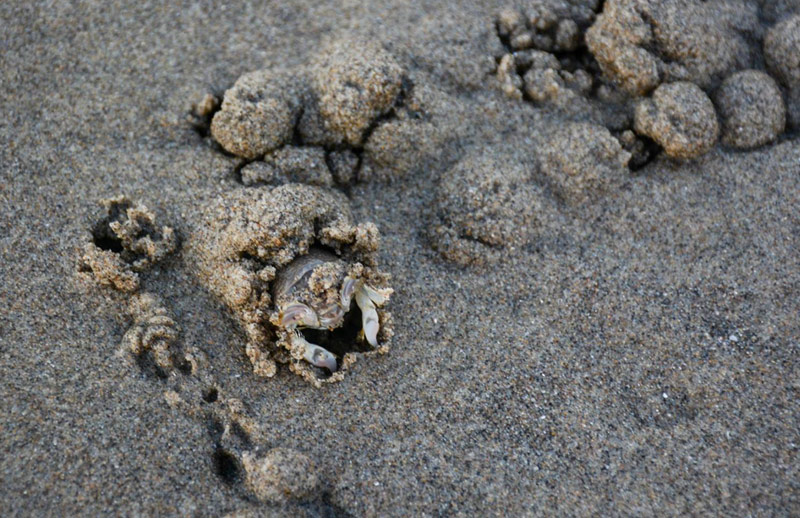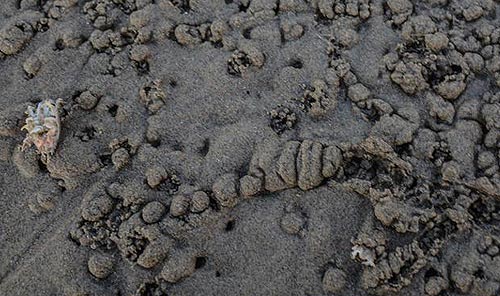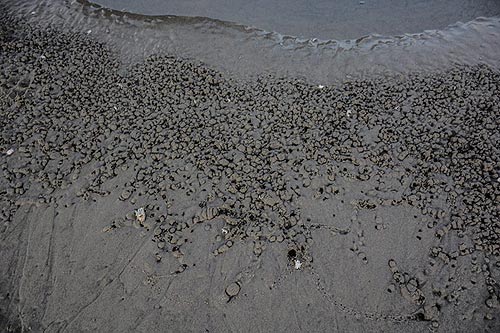Unusual Mole Crab Incident Reminder Oregon Coast is Full of the Unexpected
Published 08/04/22 at 5:45 PM PST
By Oregon Coast Beach Connection staff

Includes exclusive listings; some specials in winter
In Cannon Beach:
Includes rentals not listed anywhere else
In Manzanita, Wheeler, Rockaway Beach:
Some specials for winter
In Pacific City, Oceanside:
Some specials for winter
In Lincoln City:
Some specials for winter
In Depoe Bay, Gleneden Beach:
Some specials for winter
In Newport:
Look for some specials
In Waldport
Some specials for winter
In Yachats, Florence
Some specials for winter
Southern Oregon Coast Hotels / Lodgings
Reedsport to Brookings, places to stay; winter deals
(Seaside, Oregon) – One thing that the Oregon coast is consistent for is the unexpected – the surprises and twists 'n turns of what happens at the tideline. (All photos courtesy Seaside Aquarium)
Case in point: one natural event a few years back had some people scratching their heads initially. One winter in 2017 found a whole hoard of mole crabs apparently dead at the tideline. Tiffany Boothe of Seaside Aquarium made the discovery while beachcombing, given her pause. Lots of dead mole crabs appeared to litter the shoreline, half submerged in the sand where they usually live.
There was a big cold snap at the time – it was the end of January, after all. So maybe they were just cold-stunned?
Indeed, the oddity had at least one state expert saying he'd never seen this before.
“Most of these seemingly dead mole crabs were simply cold-stunned,” Boothe said. “The outside air temperature had been much, much cooler than the local ocean temperature (with local air temperatures around 28-34 F and ocean temperatures around 48-50 F). These poor little crabs, when uprooted by heavy surf and stranded on the beach, got too cold to burrow down into the sand.”

She said it was likely the mole crabs were revived sometime after. In the meantime, they were literally frozen in time: they normally live under the sand but were partially out, as if they were trying to wriggle out of their sandy residence when they froze.
Oregon Coast Beach Connection contacted Scott Marion, Marine Habitat Project Leader, with Oregon Department of Fish and Wildlife (ODFW) at the time. He had not heard of anything like this before, but it didn't entirely surprise him, either.
Mole crabs inhabit what is called the swash zone, he said – an area that is extremely important to near-shore environments. It's a narrow stretch that sits just beyond the tideline.
“Mole crabs' general behavior is to ride the waves into the swash zone, and they forage in the sand there and quickly bury,” Marion told Oregon Coast Beach Connection at the time. “So I can imagine if you had a combination of really big waves carrying them far up the beach and very cold temperatures that they would be slower to get buried quickly.”
Boothe said it's likely the next wave would've brought them out into that zone and warmed them up again, though it's entirely likely many died in this sudden freeze as well. Once they get revived, they would bury themselves again.

Mole crabs, normally about an inch and a half long, are indeed related to many kinds of crabs that are well known on the Oregon coast and Washington coast, but they're much smaller. They are in the same scientific order as hermit crabs, true crabs and shrimp.
Occasionally you can see the ocean appear to have a “bubbling” effect as huge numbers of mole crabs get tossed around by the tides and they struggle to dig themselves back in.
As common as they are, you don't see them that much. But in summer they come out in great droves and they feel kind of creepy as they brush across your bare feet if you're standing in the water.
Oregon Coast Hotels in this area - South Coast Hotels - Where to eat - Maps - Virtual Tours
Cannon Beach Lodging
Nehalem Bay Lodgings
Manzanita Hotels, Lodging
Three Capes Lodging
Pacific City Hotels, Lodging
Lincoln City Lodging
Depoe Bay Lodging
Newport Lodging
Waldport Lodging
Yachats Lodging
Oregon Coast Vacation Rentals
Oregon Coast Lodging Specials



More About Oregon Coast hotels, lodging.....
More About Oregon Coast Restaurants, Dining.....
LATEST Related Oregon Coast Articles
129 exclusive yellow glass floats June 1 to June 14. Lincoln City events
Oregon Coast Roadwork, Traffic Delays Coming to Port Orford's Cape Blanco, As...
Blanco this week, Astoria-Megler Bridge, Humbug Creek in Coast Range. Seaside, Cannon Beach, Bandon
Different Kind of Oregon Coast Flying Fireworks: Adorable Puffins Events at C...
Great Cannon Beach Puffin Watch from July 1 through July 4. Cannon Beach events, Manzanita, Seaside, Astoria events
Goonies Patch Offered by Astoria Police, Marks 40th Anniversary of N. Oregon ...
Commemorative patch available to fans. Astoria events, Cannon Beach events
Search for Missing Teen Called Off After Involving Coast Guard from Washingto...
Two companions that tried to help also needed rescue at Long Beach. Beach safety, sciences
Coast Guard Calls Off Search Off Oregon Coast Near Cannon Beach - No Missing ...
Reports came late on Thursday of distress flares. Weather, Seaside, Arch Cape
Spring's Weird Things Along Washington, Oregon Coast
Whale burps, ocean burps, freaky skeletons, mermaid purses, live eggs, more. Marine sciences
Newport Astrophotography Events Bring the Universe to Central Oregon Coast
July 25 at Frank Wade Park, August 16 at Newport Rec Center, Aug. 23 - 24 road trip. Nwport events
Back to Oregon Coast
Contact Advertise on Oregon Coast Beach Connection
All Content, unless otherwise attributed, copyright Oregon Coast Beach Connection. Unauthorized use or publication is not permitted



















































